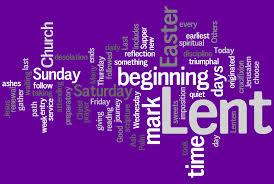With Ash Wednesday, Lent is upon us. This liturgical season consists of forty days, not including Sundays, during which persons seeking to become Catholic prepare for their baptism, confirmation, and first Communion at Easter. It is also a time when those who are already baptized Catholics (of course, many other Christian traditions practice the season of Lent, too) remember and prepare to renew their baptismal vows. As my teacher, the liturgical historian James F. White, once put it, “Lent is the season in which we participate in [Jesus’] final trip to Jerusalem and the self giving nature of love shown in Christ’s passion and death” (Introduction to Christian Worship, rev. ed. [Nashville: Abingdon Press, 1990], 74). Bruce Morrill, S.J., adds that Catholics should regard Lent “as an intense retreat…stepping away and going deeper into what this whole thing is.” In a moving reflection about Ash Wednesday, Lent, and her father’s struggle with Lou Gerhig’s Disease, Amy Levad writes,
Lent is a time when we come to know the pain of absence, rooted in our sinfulness and culminating in our deaths. We anticipate the time when we will be no more. Those small sacrifices–TV, chocolate, beer–are supposed to exemplify the ultimate loss and to draw us closer to God, who made the greatest sacrifice. We withdraw from tending to our own desires so that we may come to desire God more.
…Lent reminds us of our limitations, our inevitable deaths. But the purpose of this reminder is not to lead us into rituals of self-flagellation, in which we endeavor to sacrifice evermore to demonstrate our worthiness. It is instead a call to repentance, to turn away from those things that pull us away from loving as God loves. In addition to telling us that we are dust and to dust we shall return, the blessing that accompanies the ashes today invites us to turn toward God.
As I am writing this, the “pain of absence” and the “sinfulness” that she highlights are manifested in many ways in the U.S. and beyond. While I could concentrate on the burning of mosques, the vandalism of Jewish cemeteries and bomb threats made at Jewish community centers and schools, the murders of two wonderful men from India in a bar in Olathe, Kansas, the incredibly high percentage of pregnancies that are terminated with the “diagnosis” that the fetus has Down syndrome, or what’s been happening at Standing Rock–the litany could continue–I am only here going to revisit The Statement of Catholic Theologians on Racial Justice, which was issued just over two years ago here at Catholic Moral Theology.
Signed (so far) by 456 Catholic theologians in response to police shootings of black people in recent years–and, sadly, more victims’ names could be added since then–we pledged to “fast and to refrain from meat on Fridays…as a sign of our penitence and need of conversion from the pervasive sin of racism.” This Lent I plan to repeat what I pledged to do back then, for the sin of racism is still pervasive in the U.S., as black Catholic theologians M. Shawn Copeland, Fr. Bryan Massingale, and others have urged us to take seriously to heart. Echoing a line from Jewish philosopher and civil rights activist Abraham Joshua Heschel–“Few are guilty, but all are responsible”–Copeland remarks that “We are all responsible. It’s not about guilt. It’s about responsibility. Whether you came to the United States last week or came 300 years ago, we’re all responsible for the condition of our country.” Although I think there is more guilt here than meets the eye, rather than debate that, I totally agree that we all have a moral responsibility to do something to improve this situation.
Another part of our pledge was: “As Catholic theologians and scholars, we commit ourselves to further teaching and scholarship on racial justice.” I confess that I still have room for improvement on this commitment. A list of priorities was recently presented to the Faculty Senate here at Saint Louis University by the Student Government Association, and among them was a continued focus exclusively on white authors in many of their courses, particularly in history, but I have heard the same complaint about other disciplines, including theology. This was a problem that Margie Pfeil and I attempted to have addressed during the 2011 annual convention of the College Theology Society, where we invited plenary speakers M. Shawn Copeland and James Logan to lead us in reflecting on white privilege/supremacy and racism in our pedagogy and scholarship as theologians. Some questions for discernment they shared:
- What are the numbers of black students (along with other non-white racial and ethnic groups) you encounter in your classrooms? Do you expect black students to be (what bell hooks calls) “cultural informants,” who must take primary responsibility for teaching you and their own peers “the black perspective” on subject matter related to the courses you teach? In terms of the teaching/learning expectations in your classrooms, in what ways might the presence, or absence, of black students influence the pedagogy you typically employ in class and in other academic encounters with students?
- In the development of course syllabi and in your practices of teaching, which racial, ethnic, and gendered voices are heard most often in the materials and resources (books, essays, media, experiential learning, technology, aesthetic forms) you routinely bring to all the subject matter you teach? To what extent (or not) does the presence of colleagues from underrepresented groups (including black colleagues) inform (or otherwise influence) your engagements with the multiple voices that have contributed to the praxis of theology and religion?
- In what complex and subtle ways do you think your responses to the aforementioned questions tend to support white supremacy, privilege, and racism? How might your responses demonstrate promise in the service of dismantling these deleterious human conditions? (from Violence, Transformation, and the Sacred: “They Shall Be Called Children of God,” College Theology Society Annual Volume 57, edited by Margaret R. Pfeil and Tobias L. Winright [Maryknoll, NY: Orbis Books, 2012], 36-37).
Now, contrary to what Bill Donohue, the president and CEO of the Catholic League for Religious and Civil Rights, alleges, the Statement of Catholic Theologians on Racial Justice is not “bad,…phony hand-wringing….” Nor are all of the theologians who signed merely “classroom experts,” as he accuses, lacking real “experience” through work “in a high-crime neighborhood with blacks and Hispanics.” Actually, quite a few possess such experience, I suspect, including as pastors in inner cities, community organizers, or while conducting ethnographic field research, for instance. The old canard that academics and intellectuals lack real experience is a tiresome diversion tactic often used to attempt to write them off. As the lead author of the statement (and I’m a blue-collar, only-person-in-my-immediate-family-with-a-college-education, former corrections officer and reserve police officer, and I was raised in a very racist, rural environment–racism that I still am trying to unlearn), assisted by the subsequent four theologians immediately following my signature, I would, in retrospect, slightly modify some of what was written if it were a document coming only from me. But I think the overall thrust of the statement still stands, unfortunately.
That said, I recommit myself to spending this season of Lent doing some good, genuine “hand-wringing” through fasting, prayer (perhaps even “praying with my feet” to paraphrase Heschel’s description of his participation in a civil rights march), and reflection on what Jim Wallis at Sojourners calls America’s “original sin” in order to discern my part as a Catholic theologian in the days ahead–“to turn,” as Levad put it, “away from those things that pull us away from loving as God loves.” And I humbly invite my fellow Catholic theologians (and my fellow Catholics and others) to join me. Returning to Morrill’s line earlier, let’s embark upon a retreat during this penitential season, “stepping away and going deeper into what this whole thing is.”



